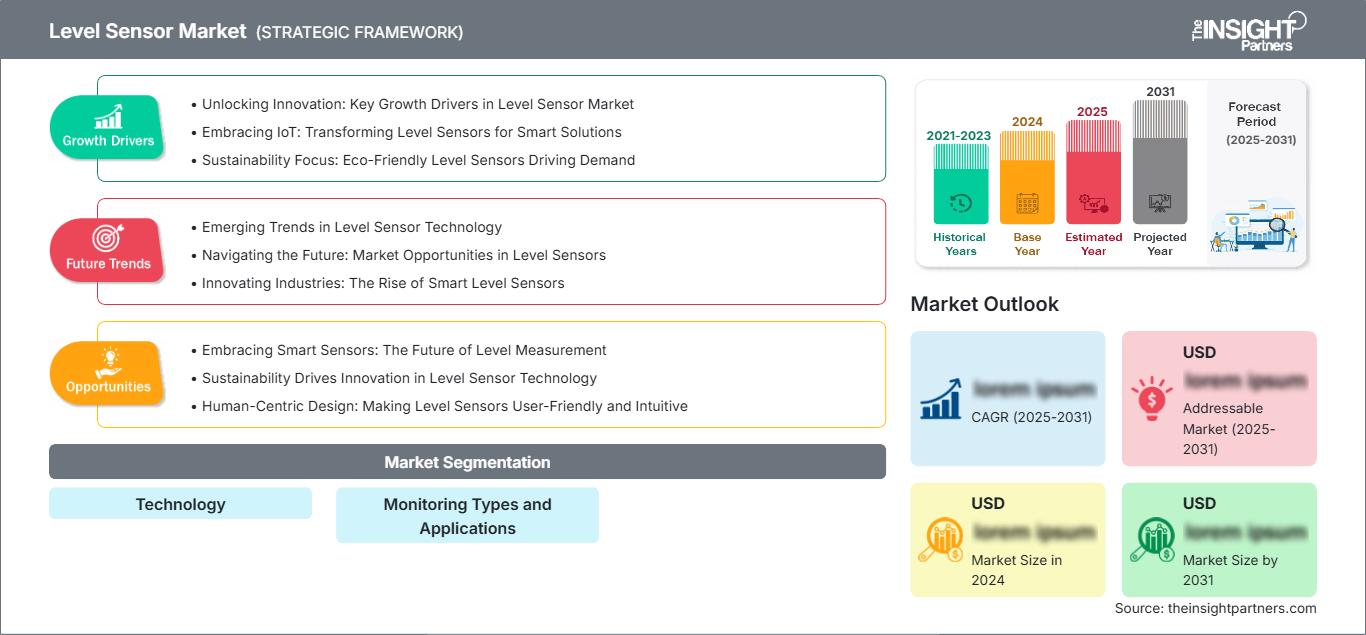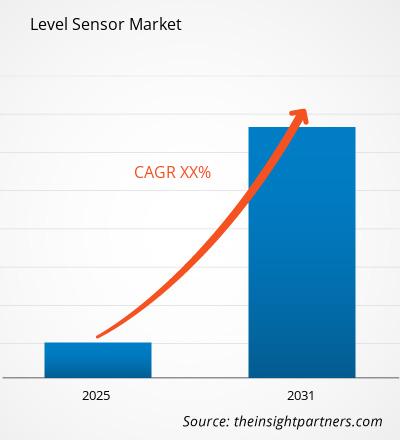레벨 센서는 액체, 유체 및 유동화된 고체의 수위를 감지하는 데 사용됩니다. 레벨 센서에는 다양한 감지 기술과 응용 분야가 포함됩니다. 더 넓은 관점에서 레벨 센서 시장은 유동화된 고체 물질을 사용하는 정지 레벨 센서 시장과 액체 물체를 사용하는 유동 레벨 센서 시장으로 나뉩니다. 디지털 전자 기술의 발전으로 사용자 친화성, 신뢰성, 접근성, 비용 절감과 같은 레벨 센서 제품의 특징이 향상되었으며, 이는 레벨 센서 시장 성장을 견인하는 것으로 분석됩니다. 또한, 산업 및 전력 부문의 정부 규제가 글로벌 레벨 센서 시장을 더욱 촉진할 것으로 예상됩니다. 제조 및 차량 생산 산업에 다목적 레벨 센서가 도입되면서 레벨 센서 시장 성장이 더욱 가속화되고 있습니다. 레벨 센서 시장의 급격한 성장을 이끄는 또 다른 요인은 레벨 센서의 소형화입니다. 아시아 태평양 지역의 빠른 성장과 여러 제조 산업의 진출로 인해 예측 기간 동안 아시아 태평양 지역의 레벨 센서 시장이 성장할 것으로 예상됩니다. 현재 시장은 접촉식 레벨 센서가 주도하고 있지만, 예측 기간 동안 비접촉식 레벨 센서 부문의 강력한 성장이 예상됩니다. 조직에서는 마이크로파, 로드셀, 초음파, 레이저, 광학 및 핵 레벨 센서와 같이 접촉 기반 레벨 센서보다 유익한 더욱 진보된 비접촉 기반 레벨 센서를 개발하고 있습니다.나노 기술에 대한 연구 개발(R&D)에 더 중점을 두고 기술 향상에 맞춰 레벨 감지 애플리케이션과 제품을 개선함으로써 글로벌 레벨 센서 시장이 크게 성장할 것으로 예상됩니다.Siemens AG, ABB Ltd., Emerson Electric Co., Honeywell Sensing & Control 등 다국적 기업은 비접촉 기반 레벨 감지 기술 내에서 혁신적인 개발을 위한 인수 및 R&D 활동에 많은 투자를 하고 있습니다.그러나 감지 제품 생산에 박막 기술이 널리 사용되면서 레벨 센서 시장이 방해를 받고 있습니다.유사한 레벨 감지 제품을 제조하기 위해 다양한 기술을 구현하는 것은 공급업체가 직면한 또 다른 주요 문제입니다.글로벌 레벨 센서 시장은 기술을 기준으로 접촉 기반 레벨 센서와 비접촉 기반 레벨 센서로 나뉩니다. 또한, 시장은 고체 레벨 센서 모니터링, 액체 레벨 센서 모니터링, 그리고 고체 및 액체 레벨 센서 모니터링 등 모니터링 유형에 따라 세분화되었습니다. 또한, 글로벌 레벨 센서 시장은 소비자 부문, ICT 및 컴퓨팅 부문, 산업 부문, 자동차 및 운송 부문, 에너지 및 유틸리티 부문, 의료 부문, 농업 부문, 군사 및 방위 부문 등 응용 분야별로 분류되었습니다. 글로벌 레벨 센서 시장은 북미, 유럽, 아시아 태평양(APAC), 중동 및 아프리카(MEA), 남미(SAM)의 5개 지역으로 구분되었습니다. 다수의 첨단 제조 시설을 갖춘 북미 지역은 글로벌 레벨 센서 시장을 선도하고 있습니다. 중국, 인도, 브라질 등 개발도상국의 정부 주도 하에 폐수 처리 사업을 추진하는 것이 레벨 센서 시장을 견인할 것으로 예상됩니다. 아시아 태평양(APAC) 지역은 기술 발전과 고성능 센서에 대한 수요 증가로 인해 글로벌 레벨 센서 시장의 핵심 지역으로 여겨집니다. 글로벌 레벨 센서 시장에서 활동하는 주요 기업으로는 Pepperl+Fuchs AG, Vega GmbH, Gems Sensors & Control Co., Magnetrol International, Inc., Honeywell International, Inc., Endress+ Hauser AG, ABB Ltd., Siemens AG 등이 있습니다.
이 보고서의 일부, 국가 수준 분석, Excel 데이터 팩을 포함하여 모든 보고서에 대한 사용자 정의를 무료로 받을 수 있을 뿐만 아니라 스타트업 및 대학을 위한 훌륭한 제안 및 할인을 이용할 수 있습니다
레벨 센서 시장: 전략적 통찰력

- 이 보고서의 주요 주요 시장 동향을 확인하세요.이 무료 샘플에는 시장 동향부터 추정 및 예측에 이르기까지 데이터 분석이 포함됩니다.
레벨 센서 시장 지역별 통찰력
The Insight Partners의 분석가들은 예측 기간 동안 레벨 센서 시장에 영향을 미치는 지역별 동향과 요인을 면밀히 분석했습니다. 이 섹션에서는 북미, 유럽, 아시아 태평양, 중동 및 아프리카, 그리고 중남미 지역의 레벨 센서 시장 부문 및 지역별 현황도 다룹니다.
레벨 센서 시장 보고서 범위
| 보고서 속성 | 세부 |
|---|---|
| 시장 규모 2024 | US$ XX million |
| 시장규모별 2031 | US$ XX Million |
| 글로벌 CAGR (2025 - 2031) | XX% |
| 이전 데이터 | 2021-2023 |
| 예측 기간 | 2025-2031 |
| 다루는 세그먼트 |
By 기술 |
| 포함된 지역 및 국가 | 북미
|
| 시장 선도 기업 및 주요 회사 프로필 |
|
레벨 센서 시장 참여자 밀도: 비즈니스 역학에 미치는 영향 이해
레벨 센서 시장은 소비자 선호도 변화, 기술 발전, 그리고 제품 이점에 대한 인식 제고 등의 요인으로 인한 최종 사용자 수요 증가에 힘입어 빠르게 성장하고 있습니다. 수요가 증가함에 따라 기업들은 제품 라인업을 확장하고, 소비자 니즈를 충족하기 위한 혁신을 추진하며, 새로운 트렌드를 적극 활용하고 있으며, 이는 시장 성장을 더욱 가속화하고 있습니다.

- 을 얻으세요 레벨 센서 시장 주요 주요 플레이어 개요
- 과거 분석(2년), 기준 연도, CAGR을 포함한 예측(7년)
- PEST 및 SWOT 분석
- 시장 규모 가치/거래량 - 글로벌, 지역, 국가
- 산업 및 경쟁 환경
- Excel 데이터세트
최근 보고서
관련 보고서
사용 후기
구매 이유
- 정보에 기반한 의사 결정
- 시장 역학 이해
- 경쟁 분석
- 고객 인사이트
- 시장 예측
- 위험 완화
- 전략 기획
- 투자 타당성 분석
- 신흥 시장 파악
- 마케팅 전략 강화
- 운영 효율성 향상
- 규제 동향에 발맞춰 대응




















 무료 샘플 받기 - 레벨 센서 시장
무료 샘플 받기 - 레벨 센서 시장